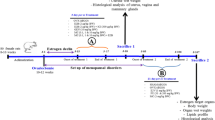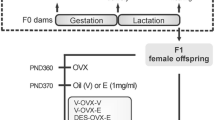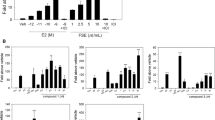Abstract
Phytoestrogens have been described as weak estrogens,selective estrogen receptor mediators (SERMs) or to exhibit antiestrogenic properties. However, information about their activity in combination with xenoestrogens and 17β-estradiol in vivo, is limited. Therefore, the combinatory activity of the phytoestrogen genistein (Gen), the industrial chemical bisphenol A (BPA), and ethinylestradiol (EE) in ovariectomized Wistar rats was analyzed in this study. All compounds were administered orally on three consecutive days (EE at 30 μg, Gen at 100 mg and BPA at 200 mg per kg body weight per day). The pure antiestrogen fulvestrant (3 mg/kg) served as estrogen receptor (ER) antagonist control. Effects on uterine wet weight, height of the uterine epithelium, uterine clusterin (Clu) and complement C3 expression, and the height of the vaginal epithelium were examined. Treatment with Gen alone resulted in a moderate stimulation of uterine weight; in the vagina the height of the epithelium was strongly stimulated. BPA did not stimulate any of the above-mentioned parameters significantly. In combination with EE, Gen acted on most of the analyzed parameters in an additive manner, whereas BPA significantly antagonized the effects of EE on the uterine epithelium and uterine Clu expression. Given in combination with Gen, BPA was also able to antagonize the stimulatory effect of Gen on the uterine epithelium. In summary, our results demonstrate that Gen, in contrast to BPA, does not exhibit any antiestrogenic properties, even if given at high concentrations. The results of this study characterize BPA as a functional antiestrogen, very likely the result of a lack of ability to activate ER-mediated transactivation after binding to the receptor. This is not the case for Gen. Our results point to the involvement of complex molecular mechanisms in the action of Gen. These mechanisms, especially the role of ERβ have to be characterized in further investigations.




Similar content being viewed by others
References
Adlercreutz H (2002) Phytoestrogens and breast cancer. J Steroid Biochem Mol Biol 83:113–118
Almstrup K, Fernandez MF, Petersen JH, Olea N, Skakkebaek NE, Leffers H (2002) Dual effects of phytoestrogens result in u-shaped dose–response curves. Environ Health Perspect 110:743–748
Anderson JJ, Anthony MS, Jordan VC, Vergote I (1999) Health potential of soy isoflavones for menopausal women. Public Health Nutr 2:489–504
Assikis VJ, Neven P, Jordan VC, Vergote I (1996) A realistic clinical perspective of tamoxifen and endometrial carcinogenesis. Eur J Cancer 32A:1464–1476
Cline JM, Hughes CL (1998) Phytochemicals for the prevention of breast and endometrial cancer. Cancer Treat Res 94:107–134
Couse JF, Lindzey J, Grandien K, Gustafsson JA, Korach KS (1997) Tissue distribution and quantitative analysis of estrogen receptor-alpha (ERalpha) and estrogen receptor-beta (ERbeta) messenger ribonucleic acid in the wild-type and ERalpha-knockout mouse. Endocrinology 138:4613–4621
Davis SR, Dalais FS, Simpson ER, Murkies AL (1999) Phytoestrogens in health and disease. Recent Prog Horm Res 54:185–210
Degen GH, Janning P, Diel P, Bolt HM (2002) Estrogenic isoflavones in rodent diets. Toxicol Lett 128:145–157
Diel P, Geis RB, Caldarelli A, Schmidt S, Leschowsky UL, Voss A, Vollmer G (2004a) The differential ability of the phytoestrogen genistein and of estradiol to induce uterine weight and proliferation in the rat is associated with a substance specific modulation of uterine gene expression. Mol Cell Endocrinol 221:21–32
Diel P, Schmidt S, Vollmer G, Janning P, Upmeier A, Michna H, Bolt HM, Degen GH (2004b) Comparative responses of three rat strains (DA/Han, Sprague-Dawley and Wistar) to treatment with environmental estrogens. Arch Toxicol 78:183–193
Diel P, Olff S, Schmidt S, Michna H (2001a) Molecular identification of potential selective estrogen receptor modulator (SERM) like properties of phytoestrogens in the human breast cancer cell line MCF-7. Planta Med 67:510–514
Diel P, Schulz T, Smolnikar K, Strunck E, Vollmer G, Michna H (2000) Ability of xeno- and phytoestrogens to modulate expression of estrogen-sensitive genes in rat uterus: estrogenicity profiles and uterotrophic activity. J Steroid Biochem Mol Biol 73:1–10
Diel P, Smolnikar K, Schulz T, Laudenbach-Leschowski U, Michna H, Vollmer G (2001b) Phytoestrogens and carcinogenesis—differential effects of genistein in experimental models of normal and malignant rat endometrium. Hum Reprod 16:997–1006
European Commission, Scientific Committee on Food. Opinion of the Scientific Committee on Food on Bisphenol A. SCF/CS/PM3936 Final 3 May 2002; EC, Brussel, Belgium; see also http://www.europa.eu.int/comm/food/fS/sc/scf/index_en.html
Fanti P, Monier-Faugere MC, Geng Z, Schmidt J, Morris PE, Cohen D, Malluche HH, (1998) The phytoestrogen genistein reduces bone loss in short-term ovariectomized rats. Osteoporos Int 8:274–281
Frasor J, Barnett DH, Danes JM, Hess R, Parlow AF, Katzenellenbogen BS (2003). Response-specific and ligand dose-dependent modulation of estrogen receptor (ER) alpha activity by ERbeta in the uterus. Endocrinology 144:3159–3166
Fritz WA, Coward L, Wang J, Lamartiniere CA (1998) Dietary genistein: perinatal mammary cancer prevention, bioavailability and toxicity testing in the rat. Carcinogenesis 19:2151–2158
Fuchs-Young R, Glasebrook AL, Short LL, Draper MW, Rippy MK, Cole HW, Magee DE, Termine JD, Bryant HU (1995) Raloxifene is a tissue-selective agonist/antagonist that functions through the estrogen receptor. Ann NY Acad Sci 761:355–360
Gould JC, Leonard LS, Maness SC, Wagner BL, Conner K, Zacharewski T, Safe S, McDonnell DP, Gaido KW (1998) Bisphenol A interacts with the estrogen receptor alpha in a distinct manner from estradiol. Mol Cell Endocrinol 142:203–214
Haapiainen R, Rannikko S, Alfthan O, Adlercreutz H (1988) Pretreatment hormone levels in prostatic cancer. Scand J Urol Nephrol 110:137–143
Hall JM, McDonnell DP (1999) The estrogen receptor beta-isoform (ERbeta) of the human estrogen receptor modulates ERalpha transcriptional activity and is a key regulator of the cellular response to estrogens and antiestrogens. Endocrinology 140:5566–5578
Hertrampf T, Schmidt S, Seibel J, Laudenbach-Leschowsky U, Degen GH, Diel P (2006) Effects of genistein on the mammary gland proliferation of adult ovariectomized Wistar rats. Planta Med (in press)
Hewitt SC, Korach KS (2003) Oestrogen receptor knockout mice: roles for oestrogen receptors alpha and beta in reproductive tissues. Reproduction 125:143–149
Hiroi H, Tsutsumi O, Momoeda M, Takai Y, Osuga Y, Taketani Y (1999) Differential interaction of bisphenol A and 17ß-estradiol with estrogen receptor α (ERα) and ERβ. Endocr J 46:773–778
Knauthe R, Diel P, Hegele Hartung C, Engehaupt A, Fritzemeier KH (1996) Sexual dimorphism of steroid hormone receptor messenger ribonucleic acid expression and hormonal regulation in rat vascular tissue. Endocrinology 137:3220–3226
Kuiper GG, Carlsson B, Grandien K, Enmark E, Haggblad J, Nilsson S, Gustafson JA (1997) Comparison of the ligand binding specificity and transcript tissue distribution of estrogen receptors alpha and beta. Endocrinology 138:863–870
Mueller SO, Simon S, Chae K, Metzler M, Korach KS (2004) Phytoestrogens and their human metabolites show distinct agonistic and antagonistic properties on estrogen receptor alpha (ERalpha) and ERbeta in human cells. Toxicol Sci 80:14–25
Murphy LD, Herzo CH, Rudik JB, Fojo AT, Bates SE (1990) Use of polymerase chain reaction in the quantitation of mdr-1 gene expression. Biochemistry 29:10351–10356
Patisaul HB, Whitten P (1999) Dietary phytoestrogens. In: Naz RK (ed) Endocrine disruptors: effects on male and female reproductive systems CRC Press, Boca Raton, pp 89–123
Pike AC, Brzozowski AM, Hubbard RE, Bonn T, Thorsell AG, Engstrom O, Ljunggren J, Gustafsson JA Carlquist M (1999) Structure of the ligand-binding domain of oestrogen receptor beta in the presence of a partial agonist and a full antagonist. EMBO J S18:4608–4618
Ramsey LA, Ross BS, Fischer RG (1999) Phytoestrogens and the management of menopause. Adv Nurse Pract 7:26–30
Russell L, Hicks GS, Low AK, Shepherd JM, Brown CA (2002) Phytoestrogens: a viable option? Am J Med Sci 324:185–188
Saunders PT, Maguire SM, Gaughan J, Millar MR (1997) Expression of oestrogen receptor beta (ER beta) in multiple rat tissues visualised by immunohistochemistry. J Endocrinol 154:R13–R16
Shughrue PJ, Lane MV, Scrimo PJ, Merchenthaler I (1998) Comparative distribution of estrogen receptor-alpha (ER-alpha) and beta (ER-beta) mRNA in the rat pituitary, gonad, and reproductive tract. Steroids 63:498–504
Tinwell H, Ashby J (2004) Sensitivity of the immature rat uterotrophic assay to mixtures of estrogens. Environ Health Perspect 112:575–582
Vik DP, Amiguet P, Moffat GJ, Fey M, Amiguet-Barras F, Wetsel RA, Tack BF (1991) Structural features of the human C3 gene: intron/exon organization, transcriptional start site, and promoter region sequence. Biochemistry 30:1080–1085
Weihua Z, Saji S, Makinen S, Cheng G, Jensen EV, Warner M, Gustafsson JA (2000) Estrogen receptor (ER) beta, a modulator of ERalpha in the uterus. Proc Natl Acad Sci USA 97:5936–5941
Wu AH, Wan P, Hankin J, Tseng CC, Yu MC, Pike MC (2002) Adolescent and adult soy intake and risk of breast cancer in asian-americans. Carcinogenesis 23:1491–1496
Wuttke W, Jarry H, Becker T, Schultens A, Christoffel V, Gorkow C, Seidlova-Wuttke D (2003) Phytoestrogens: endocrine disruptors or replacement for hormone replacement therapy? Maturitas 44:9–20
Yamamoto S, Sobue T, Kobayashi M, Sasaki S, Tsugane S (2003) Japan public health center-based prospective study on cancer cardiovascular diseases group. Soy, isoflavones, and breast cancer risk in Japan. J Natl Cancer Inst 95:906–913
Acknowledgments
We thank Ute Laudenbach-Leschowsky for brilliant technical assistance. This study was supported by the Deutsche Forschungsgemeinschaft grants Di 716/9–1 and Vo 410/6–3
Author information
Authors and Affiliations
Corresponding author
Rights and permissions
About this article
Cite this article
Schmidt, S., Degen, G.H., Seibel, J. et al. Hormonal activity of combinations of genistein, bisphenol A and 17β-estradiol in the female Wistar rat. Arch Toxicol 80, 839–845 (2006). https://doi.org/10.1007/s00204-006-0102-4
Received:
Accepted:
Published:
Issue Date:
DOI: https://doi.org/10.1007/s00204-006-0102-4




